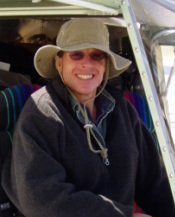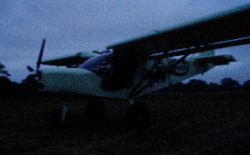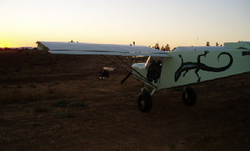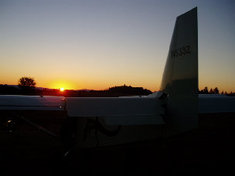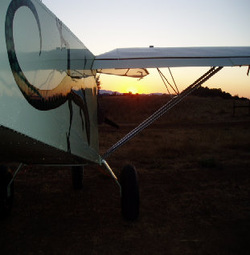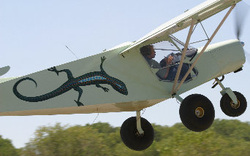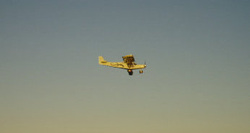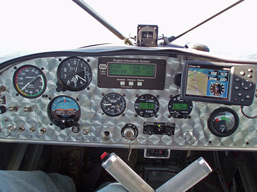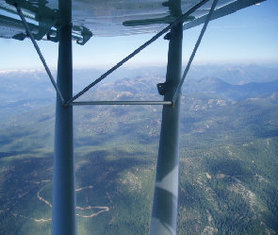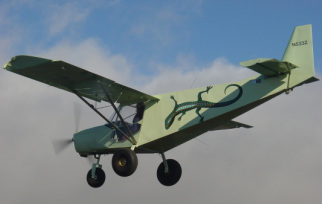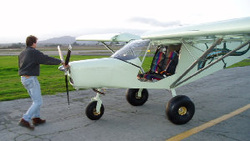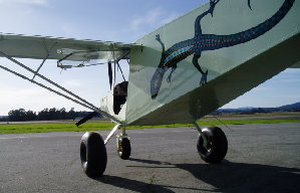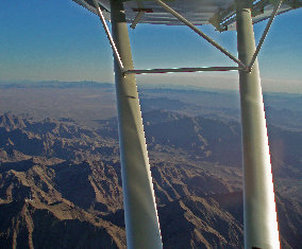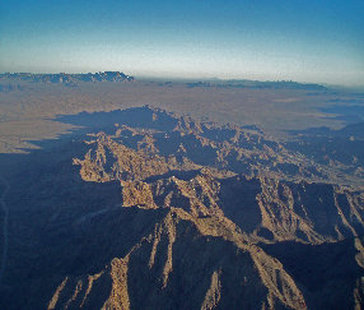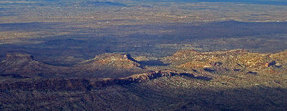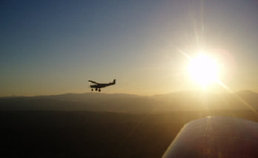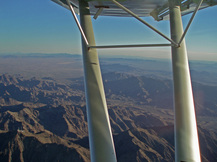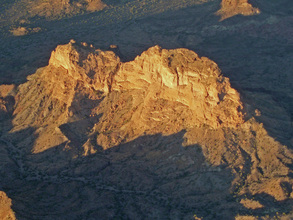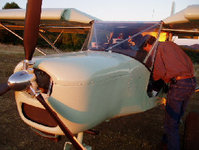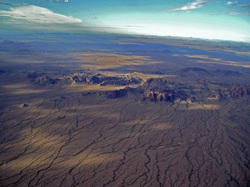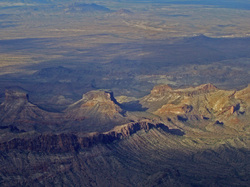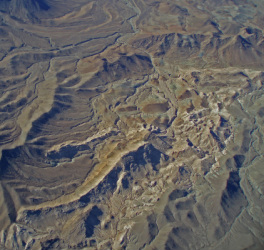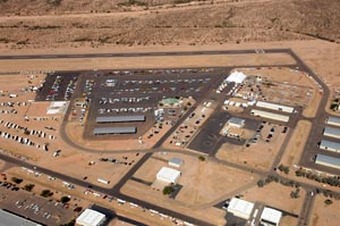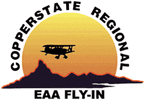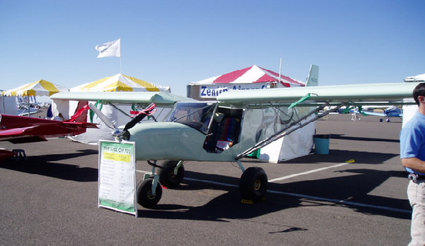SAN FRANCISCO TO COPPERSTATE
A Light Sport Adventure - by Christopher Desmond
|
Christopher Desmond is the proud owner of the Zenith STOL CH-701 depicted above. His "Centennial" kitplane was built in northern California by Robert Kube, a retired machinist. This beautifully finished Zenith kit won "Best of Show" at the Watsonville (CA) Fly-in in 2005.
It did not take long for Christopher to land and take off from gravel bars, meadows, and mountain-top ridges with his CH 701; in the year and a half before this story was written, he had flown over 300 hours in his big-footed, reptilian bush-plane. It wasn't long after this trip that Christopher launched Stol-Adventures.com... Since then, he has flown to EAA's Copperstate and Arlington Fly-ins numerous times; another memorable trip was his flight to Oshkosh. |
I had been lying awake for some time, filled with anticipation of the long cross-country flight that would begin at daybreak. I would be flying to Casa Grande, Arizona home of the EAA’s annual Copperstate Fly-in. As I waited for the alarm to signal five a.m., my mind was going through the details of last-minute preparations. To avoid forgetting, I had taped the keys belonging to my experimental airplane, a Zenith STOL CH-701, to the I-com portable so that I wouldn’t take off with my back-up radio still sitting in the charger at the rear of my workbench. After going through the list of things not to forget several more times, my mind switched to the VFR routing that I had worked out the night before. I would be stopping only twice. The trip would be divided into three, three-hour legs. Beyond the first fuel stop there would be the mountains. My mind switched again. The last weather check before I went to bed included an AIRMET for moderate turbulence over high terrain. I would be traversing lots of high terrain.
|
I rolled out of bed 10 minutes before the alarm went off. Forget the shower, I thought, too much to do and anyway, I’d be flying alone. First, I checked the updated forecast. No change. No big deal except for the turbulence. A piece of cornbread for breakfast. Then, in the chill of the pre-dawn air, a short walk from the house out to the barn where my plane was waiting. My house, with its five-hundred foot grass airstrip is located fifty miles north of San Francisco, and about 750 miles northwest of Casa Grande. |
|
There is always something special about that moment, in the almost darkness, when the barn doors roll back and the silhouette of my little bush plane appears, barely visible, as it slumbers amidst the scent of leather saddles, horses and hay. I always pause there for a moment appreciating how fortunate I am to finally be living my dream; a dream that I had worked toward for so many years. |
|
As I began to tug against the prop hub, the 701 resisted, pulling back as if to say that it was way too early. In reality, it was the 26-inch tundra tires with only 5 pounds of pressure that were resisting. Overnight, they had settled a bit deeper into their flat-bottomed shape. If I expected to be followed out of the barn, I would have to pull harder and really lean into it. The short path leading from the barn to the runway is slightly down hill, so once outside, the plane would roll willingly. |
|
Out on the runway, I used a flashlight to complete my walk-around as the eastern horizon was just beginning to turn early morning shades of pink and yellow. The 701, a high wing, tri-gear, all metal airplane, easily meets the FAA definition for Light Sport Aircraft. Its max cruise is well under 120 knots, has only two seats, and its gross weight is 200 pounds less than the maximum. Moreover, it has a stall speed that would make most pelicans envious. The Zenith 701 was designed twenty years ago by the internationally renowned aeronautical engineer, Chris Heintz. He created a very capable, rugged, back-country bush plane that is more at home on a gravel bar than on tarmac. Equally comfortable on skis, floats or tundra tires, the 701’s maneuverability, forgiving flight characteristics, and STOL performance are unsurpassed. |
A few minutes after the preflight, both my seatbelt and the master switch clicked, one after the other. The 100 horse engine, a Rotax 912 ULS, came to life effortlessly, followed by the avionics. Fifteen minutes later, with the engine warm, the run-up and the pre-takeoff items checked, I started to taxi. As I turned the plane toward the departure end of the runway, I caught a glimpse of someone waving at me. Unfortunately, it was a “stop & come here” sort of wave from one of our employees. I acknowledged him with a forced smile, shut down the engine and climbed out.
|
More than two hours later, with my cell phone to my ear, I listened to an updated winds-aloft forecast as I strode back across the lawn to the plane. It was just as I had left it, seatbelt dangling out of the open door. The autumn sun was starting to get warm. So much for an early departure. After an abbreviated walk-around, all of the takeoff items were rechecked. The second engine run-up and mag check of the morning were just as smooth as the first. Finally, I advanced the throttle to full power. Less than five seconds later, I was flying. |
|
The ground adjustable Warp Drive prop (carbon fiber, three-blade, 70 inch) was set to a cruise pitch of 13.5 degrees. Even so, the take-off and climb performance are nothing short of amazing. The take-off ground roll is just under 100 feet with a climb rate of 800 feet per minute while loaded with full fuel (24 gallons), eighty pounds of gear, and me. |
I maintained the northerly runway heading for only a minute or two before making my initial turn to the southeast. Settling in for the first leg of the flight, I began taking care of various routine tasks. I pushed the direct-to button on my Garmin 396. When the identifier for my initial fuel stop was entered, the GPS unit instantly offered much more information than I would ever need. The heading I was looking for was superimposed over the moving map and I reflexively gave the center control stick a slight nudge. The left wing dipped a bit. I was turning in order to pass east of Oakland’s Class “C” airspace. After a ten-degree correction, I rolled out and as I passed through 1500 feet, I contacted Oakland Center to request flight-following radar services. The controller bid me “good morning” and gave me a squawk code and an altimeter setting. A minute later he came back with “radar contact” and confirmed my position and altitude. What a great service, I thought to myself as I listened to various airline crews and other pilots check in with the controller who would then guide them safely through his sector.
|
The Rotax 912 ULS engine makes its full 100 hp. at the max allowable rpm of 5800, which is limited to five-minute “bursts”. The maximum continuous rpm of 5500 produces somewhat less power. In cruise flight, with my current prop setting, the engine turns at an easy 5200 to 5300 rpm, burning less than 5 gallons per hour. Thus configured, my 701 maintains an airspeed between 95 to 100 mph. (The tundra tires seem not to impose much of a speed penalty.) |
|
As I left the San Francisco Bay Area behind and headed southeast across California’s central valley, my GPS ground speed, when compared to the indicated air speed, showed that I had a 10 to 15 mph headwind. From Oakland Center I was handed off to Nor Cal Approach, then to Lamoore Approach (Naval Air Station), and finally to Bakersfield Approach. I had planned to land at a small, uncontrolled airfield called Shafter Minter (MIT). It was just north of Bakersfield. I hoped to get in, refuel and be on my way again with a minimum of fuss. The facilities at MIT were minimal but the four things I required were right there. Next to the fuel pump were a ladder, a trash can, and an outhouse. Fifteen minutes later I was back in the air. |
|
The first leg of the flight turned out to be 3.2 hours. The hourly fuel burn was as expected. The plane was running really well. As I climbed out over Bakersfield’s Class “D”, I took a more easterly track. The terrain was rising. I was heading for a mountain pass that lies just west of Tehachapi. I contacted Flight Watch on 122.0 to check on the weather. The specialist informed me that the AIRMET for turbulence was still in effect. He advised me that there had been no pilot reports of rough air, but that, in any case, altitude would be my friend. I pressed onward and continued to climb. By the time I was flying through the pass I had reached 10,500 feet. At that altitude my cruise performance was still quite good and, thankfully, the ride was fairly smooth.
|
I deviated to the south to avoid the restricted airspace around Edwards Air Force Base. Then I headed east for an hour prior to turning southeast again toward Palm Springs. As I got closer, I began to hear the controllers directing other airplanes around a massive forest fire that was raging to the west of Palm Springs. There was a TFR up to 10,000 feet over the fire. Looking west, I could see great billowing columns of smoke engulfing the whole area. I would later learn that, tragically, this fire took the lives of five firefighters.
|
As I came out of the mountains I descended into the valley east of Palm Springs. Bermuda Dunes was my second fuel stop. BDD is an uncontrolled field with a full service FBO. The line guys went to get the fuel truck and I gave instructions to fill both tanks to the top. I ran into the office to use the facilities and pay for the gas. There were 3 hours of daylight left for my last three hours of flying. I would be cutting it close. |
|
I returned to the plane as the fuel truck pulled away. Out of habit, I made sure to look for the 100LL markings on the truck (we’ve all heard that Jet-A makes the Rotax engine run a little rough…) The airplane had been flying really well in every respect, and I was in a big rush to get airborne. I hesitated at the thought of the time delay required, but nevertheless, I forced myself to complete a thorough preflight. As it turned out, omitting the preflight checks would have been a very bad decision. To my astonishment I found that one of the gas caps had been just set loosely back on top of the filler neck without being turned to secure it. Just sitting there, the cap looked as if it had been properly replaced. Only by actually putting my hand on the cap did I detect the line-boy’s mistake. From inside my high-wing plane I wouldn’t have noticed the steady stream of fuel that would have been sucked out by the low pressure above the wing. I have no doubt that I could have put my plane down safely in some part of Arizona’s forbidding moonscape. But, at best, that would have meant at least one very long, very cold night in the middle of nowhere... I don’t think I’ll be tempted to skip a walk-around preflight again anytime soon! |
With a simple twist of my wrist, the cap was secured and I was on my way again. The GPS helped me dodge various chunks of restricted airspace. I heard other pilots asking permission to pass through this or that restricted area but ATC continued to reply that it was all “hot.” I was content to fly around.
|
A couple of hours east of Palm Springs it seemed that due to slight headwinds and the few deviations for airspace, sunset was now closer than my destination. The big question: Do I press on to Casa Grande or divert north to ensure that I can be on the ground before dark? Diverting would involve a huge inconvenience that would include spending the night in Buckeye, Arizona. An airport facility guide indicated that Buckeye did have a motel in town, six miles from the field. But did they have any vacancies? How would I get to town? Also, my friends were waiting for me at Copperstate. I was fully qualified to fly at night (on my private ticket) and my airplane was equipped with lights. But... The destination airport was unfamiliar to me, as was the terrain that I’d have to cross to get there. I was sure that I would be fine if I just stayed high and let down over the city lights. But... How close was the airport to the city lights? The safest thing to do would be to divert and land before dark. No... Diverting is ridiculous. I am a good pilot. If I continued I would be landing in Casa Grande one half hour after sunset. Therefore, it would still be twilight almost all of the way in. If I continued on, the night landing might be a bit of a challenge but that’s part of the fun and excitement of flying. Worse case, I’d bounce a time or two on landing. So what’s the big deal? I would be fine.
|
.
|
|
The sun was just setting as I tied down my plane on the ramp. A couple of people were camping under their wing a few spaces away. At first I thought they were headed to the fly-in. Lots of people camp at fly-ins. But they said no, they were just flying from place to place. One wing of their Cessna 182 was draped with a tarp and had a tent beneath. Dinner was simmering on a gas cook-stove set up on the tail. They were very friendly and as they were telling me that there was nobody about, a pair of headlights came toward us, bobbing up and down as the car traversed the uneven pavement beyond. The low-slung, old Cadillac came to a halt and a man got out. He said that he had seen my lights as I was coming in on final. He had come to see if anybody needed a ride into town. How lucky can I be? I thought.
|
|
The man talked with the campers while I finished securing my plane. When I approached his car he gestured for me to climb in. “My name is Freak,” he said in a loud voice with a big smile. “F-R-E-E-K” he spelled it for me. “Going into town for some more beer anyway,” he added. “I’m the instructor at the Jump Club.” In addition to being a nice guy, Freek was quite a colorful character. He wouldn’t take any money for gas. I thanked him and bid him well as I closed the door of the Caddie. He drove off in search of beer. |
|
Inside the lobby, luck was with me again: I got the second to last room at the motel. After stowing my bag in the room, I walked across the expanse of well-lit pavement to the adjacent truck-stop. Big-rigs were everywhere. There must have been forty to fifty. Many were refueling. Many were parked, one right next to the other with running lights on and engines idling. Inside, I waited in line with the truckers to purchase my dinner. Rather than eat at the truck-stop, I took my submarine sandwich back to the room. I let my friends at Copperstate know that I would be continuing at first light. I called home and reported the events of the day, and then turned in for the night. As I was falling asleep, I remember thinking that if my departure hadn’t been delayed I would have made the whole trip in one day. Amazing . . . |
|
The next morning, I was thrilled to find that the taxicab I had called was actually waiting for me at six a.m. The ride back to the airfield was short. I refueled, then pre-flighted the plane and was in the air by six forty-five. My GPS was reporting thirty minutes to Casa Grande with a ground speed of 110 mph. I was excited. |
The FAA had set up a temporary tower for the event. I tuned my radio to 118.6. That was the frequency that my buddy, who was already at the fly-in, had given me. Wow, was it busy! What are all of these guys doing up so early? I couldn’t have gotten a word in edgewise. As I listened, I realized that my buddy hadn’t given me the whole story. The tower controller was doing ninety-five percent of the talking. He was recognizing and calling out aircraft by color, high-wing, low-wing or type. A specific instruction to insure separation would follow each call. Rather than asking for a reply, he would occasionally direct a pilot to “Rock your wings.” He was expertly spacing the steady stream of arriving aircraft. But who was organizing the incoming swarm into that steady stream? There must be more to this arrival procedure than just calling the tower. It occurred to me that my preparation for this final phase of the trip was seriously lacking. I waited for about five minutes for the radio traffic to let up, and when it did, I seized the moment and called in, “Experimental 533Zulu inbound please clarify arrival procedure.” Without breaking cadence, the controller simply inserted “Aircraft inbound to Copperstate first contact Approach on 118.9” then he seamlessly continued his rhythmic monolog, first recognizing, then separating, sequencing, and finally giving clearances to land.
|
That was exactly the piece of information I needed. I switched frequencies and just listened. You can learn a lot by listening. It is always a good habit, but it’s especially important when lost or a bit confused like I was. All of the arriving traffic was being told to “Report over the Pit”. All of the planes that were reporting “Over the Pit” were then being told to “Continue inbound on the forty-five, enter a right downwind for runway 23 and monitor the tower on 118.6.” Great! Now, if only I knew what “the Pit” was and how to find it. Again I waited for a break. When I finally keyed my mic I said, “Experimental 533Zulu inbound, not familiar with the Pit.” The controller answered, “33Zulu Rodger, the Pit is a big, deep hole in the ground about 5 miles northwest of the field. Stay clear of the airport and report finding the Pit.” I acknowledged, and, keeping my eyes peeled for other inbound airplanes, I set out to find the big hole in the ground.
|
|
Since I was approaching from the north-northwest and was still ten miles out, I circled a bit further to the west and then turned to track inbound again on what was, essentially, a ten mile forty-five. I reasoned that this course should take me over a point five miles northwest of the airport and thus, hopefully, right over “the Pit”. Five miles later, there it was! It was unmistakably a huge, deep hole, probably a quarry, and it was directly below me. Relieved, I keyed the mic again, “Copperstate Approach, Experimental 33Zulu over the Pit inbound for landing.” I was told to continue and enter the right downwind for runway 23 and to switch to and monitor the tower.
|
|
I switched to the tower frequency. They were busy trying to sort out some confusion with another airplane. As I started my turn onto the downwind I heard the controller call: “High-wing Experimental turning downwind, you are cleared to land runway 23.” The controller then resumed talking with a pilot who sounded a bit lost. This older gent had somehow ended up on the wrong side of the airport. He was reporting that he thought he was only a few miles out, coming in from the southeast, airport not in sight. All of a sudden he reported spotting the runway. He was close. I wanted to stay clear of this situation, so, having already been cleared to land, I turned directly for the numbers. I lowered my right wing, chopped the power and added full top-rudder while pushing the nose firmly over, creating a big slip. |
|
In my airplane such a slip gives me quite an elevator ride, almost straight down at 1500 fpm. With this maneuver, starting from my downwind position abeam the numbers, I entered a steep-descending 180-degree turn and dropped onto short final in a matter of seconds. The controller, who was starting to tell the confused pilot to turn away from the airport, saw the opening that I had created and changed his call. He said, “Continue directly to the runway sir, you are now cleared to land, number two, follow the high-wing aircraft on short final.” It always feels good when I can help make things work out utilizing the capabilities of my remarkable airplane. |
At the event, I visited with friends, met many interesting people, talked with vendors, and saw scores of beautiful airplanes. When Sunday morning came, two days later, I headed for home. I departed before seven a.m. After a full day of wonderful flying, with many good memories of a great Light-Sport adventure, I was home. I pushed my plane back into the barn at four fifteen that same afternoon. My relatively slow Light Sport Airplane had flown from southeast of Phoenix to fifty miles northwest of San Francisco in a single day! While unsurpassed in short-field operations, the CH-701 from Zenith demonstrated that it’s also quite a capable cross-country performer. And once again, the annual Copperstate Fly-in was a huge success.
